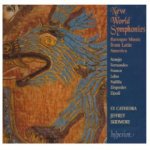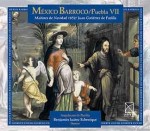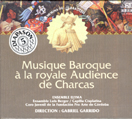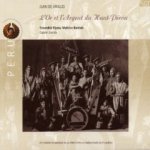Baroque Gold of El Dorado

Bolivian art from the 18th century
I know it’s politically incorrect to suggest anything good came of the arrival of Europeans in Latin America. Yes, the conquistadors were rapacious churls who subjugated the natives and yes, they did commit barbaric acts. As is usually the case, missionaries followed hard on the heels of the European soldiers who arrived in Latin America. And yes, the natives were not necessarily looking for a new religion. (And yes, their old religion included human sacrifice.) But…

Bad conquistador!
One of the best things that Franciscan, Dominican and Jesuit missionaries shared with the native populace was music. According to the great musicologist Robert Stevenson, Hernando Cortez (Cortez the Killer for you Neil Young fans) had a band of Spanish minstrels traveling along with his army to entertain himself and his soldiers. Speaking of Stevenson, if you want to learn anything about the music of Latin America, read his Music in the Aztec and Inca Territory.
In 1609 it was primarily Jesuits who established the first settlements or “reductions” in what was then Paraguay and now includes Argentina, Uruguay, Chile, Bolivia, and Brazil. Music was one of the subtle tools the Jesuits used to convert the natives.
For over a century and a half the Jesuits lived and worked with native peoples, and both groups shared cultures and music. Jesuit successes threatened the economic boom that the slave trade brought to Europe, so the Jesuits were eventually expelled from Latin America by order of King Carlos III. This was one of the subjects of the magnificent film The Mission.

An actor portraying a good Jesuit and oboist
The music that was played in the Jesuit missions represents a spectacular cultural fusion. Missionaries came from all over Europe, with Spaniards and Italians dominating. The music followed the European Renaissance and Baroque styles—mostly polyphonic Masses and Psalm settings. But here’s the really good bit: European composers added native colors and rhythms to the long-established liturgical forms. And then native composers (educated by missionaries) picked up the European forms and merged them with their own music.
The recordings
I’ve been crazy for this music for over a decade and have collected dozens of recordings. It offers the best of all worlds: luscious Italianate melodies wed to some of the most driving rhythms you will hear this side of the Fania All-Stars. A uniquely Latin sound colors the music. It’s present in the spicy instrumentation, which frequently includes guitars, bandolas, harps and a battery of exotic percussion. The native mix is combined with many instruments found in European baroque music, such as trumpets, recorders, oboes and bassoon, as well as the standard continuo instruments like the harpsichord and organ. If you are setting out to explore this music, here are some of the recordings you must have:

Spain in the New World
Hesperus
(Koch)
Spanish songs and instrumental music are performed by the late Scott Reiss, Tina Chancey and company on this recording. The disc Includes songs by the Canichanas Indians of Bolivia and showcases the impact native rhythms made on old Spanish forms.

New World Symphonies
Ex Cathedra
(Hyperion)
This is probably the best one-CD collection of the music – as a matter of fact the disc’s subtitle is From Araujo to Zipoli: an A to Z of Latin American Baroque – and features top-notch performances of music by the key composers of the genre. The centerpiece of this recording on the Hyperion label is the Missa Ego flos campi by the most well-known of all the New World composers, Juan Gutiérrez Padilla (1590-1664).
At any rate, villancicos and motets by other composers of the period are interspersed between movements of the mass. It’s a spectacular recording and one of my favorites. Ex Cathedra have two more discs of this music on Hyperion: Moon, sun & all things (CDA67524) and Fire Burning in Snow (CDA67600). Get them all and thank me later.

Padilla: Maitines de Navidad 1652
Angelicum de Puebla
(Urtext Digital Classics)
Speaking of Padilla, the Mexican Urtext label has released several excellent recordings of his music in their ongoing Mexico Barocco series. My favorite in the series is Maitines de Navidad 1652, a collection of villancicos for Christmas. Very simply stated, a villancico is a song form that was born in Spain. When the form took root in Latin America it embraced rustic themes and pastoral imagery. Some of the most exciting music in Mexico are the rhythmically charged villancicos for Christmas by Padilla. One down side to the Urtext recordings, the texts are in Spanish only but the music is so infectious it really doesn’t matter.

Missa Mexicana
The Harp Consort
(Harmonia Mundi)
While I’m on the subject of Padilla and Mexico, another essential recording is the Harp Consort’s superb Missa Mexicana. Here’s the Missa Ego flos campi again but this time with some gorgeous dance music and villancicos interspersed between the mass movements. The performances by Andrew Lawrence-King’s Harp Consort are brilliant.
The Great Garrido
No musician has done more for this music than the Argentine director of Ensemble Elyma, Gabriel Garrido. Garrido has an impressive discography on the French label K617. K617 recordings can sometimes be frustrating because they rarely provide English translations to the obscure texts of much of this music. No matter, you can’t go wrong with any of the recordings Garrido has made with his excellent Ensemble Elyma. If pressed, I would say you should hunt down these five essential recordings:

Lima – La Plata
Music by Araujo, Zipoli, Velasco and Salazar

Domenico Zipoli: Vespres De San Ignacio

Musique Baroque a la Royale Audience de Charcas

Torrejón y Velasco: Musique á la Cité des Rois

L’Or & L’Argent du haut – Pérou
The best way to go, if you can find the recordings, are two big boxed K617 sets Musiques Sacrées Missionnaires, Volumes I & II. The specially priced boxes contain most of the Garrido recordings mentioned above along with music from the missions in Québec and Montréal as well as complete discs devoted to music by Domenico Zipoli.

Here’s a villancico by Juan de Araujo performed by Garrido and his ensemble, the image is static but the music will have you jumping
Please let me know what you think about your explorations of this glorious music. I have dozens more recording recommendations if you are interested.
September 18, 2009 at 5:43
I haven’t seen Aguirre, Wrath of God in years. It was one of my favorites. Who knew Klaus Kinski would be featured in such a terrific exploration of Latin American Baroque recordings. Klaus Kinski is good for almost any occasion, isn’t he?
September 18, 2009 at 5:43
One of the greats. Aguirre was my second Kinski – Herzog film. It left a huge mark on me. Aguirre on a CD cover, might be interesting.